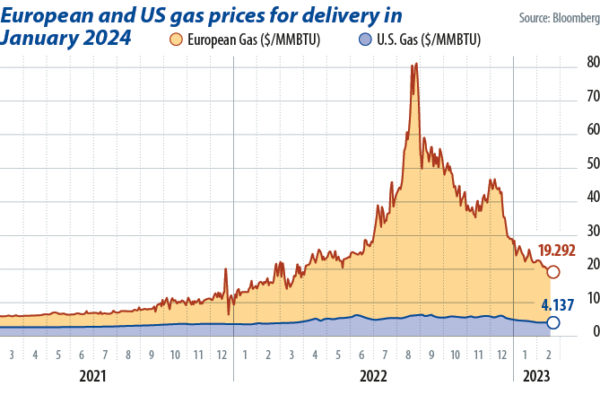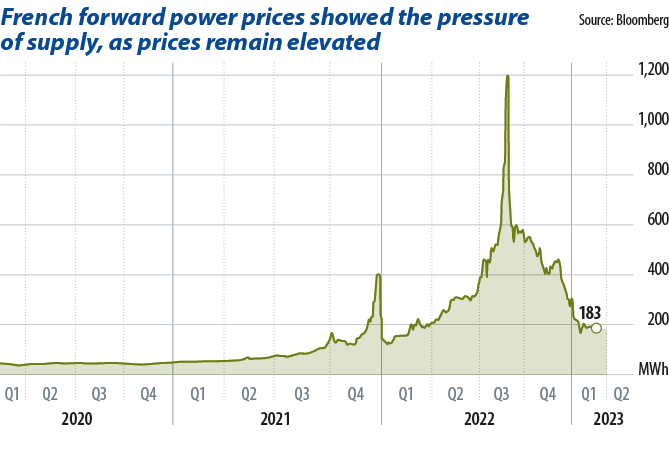The good news is that winter is behind us in Europe and there have been no blackouts or emergency rationing of natural gas and other fuels. The bad news is that Europe has a multitude of challenges going forward, starting with more expensive energy, poor positioning in key energy technologies, and the growing threat to European industry from the US Inflation Reduction Act (IRA).
Together, these factors threaten to undermine Europe’s competitiveness and living standards. To combat these risks, Europe needs to respond rapidly with a long-term, joined-up strategy.
Back in August of 2022, as prices for electricity, coal, diesel, and natural gas hit all-time highs, it was not clear whether Europe would be able to get through the winter without significant damage to its economy. Energy users reacted to high prices by reducing demand and by moving away from natural gas to alternatives such as coal, wood, and oil; averting part of the economic impact.
Warm winter
The weather gods were also kind. Europe had a warm winter, including record temperatures in December and January across many regions. France also did a stellar job, considering that in August more than half of its nuclear reactors were down for repairs and not expected to be back online in time for the winter months. That would have caused a significant risk of blackouts. Instead, by the start of January, almost three-quarters of the French nuclear fleet was up and running.
Natural gas storage levels across Europe are very high now thanks to lower demand for the fuel and the aggressive purchase of liquefied natural gas (LNG) under order from the European Commission. Add the fact that Germany and Finland have now opened a handful of floating storage and regasification units and – in the worst-case scenario – Europe can do without any Russian gas, going forward.
Gas price
Despite these successes, the continent is still facing high gas prices in future as well as increased volatility of power prices and risks. Replacing low-cost Russian pipeline gas with more expensive LNG means that European consumers are going to face higher prices in the months ahead. The silver lining is that customers will be forced to become more efficient and move to cleaner alternatives such as heat pumps.
Facing gas prices that will remain substantially higher than they have been in the past will cause competitive problems for European heavy industry, however. To add to these worries, US President Joe Biden’s IRA incentives will reduce the cost of power for US electricity buyers, which will increase the nation’s energy-cost advantage. The IRA also incentivizes local production of key decarbonization technology, such as batteries and solar panels, and it will help the United States reindustrialize around these key future-growth technologies.

Meanwhile, back in Europe, there is not one manufacturer of lithium-ion batteries or solar panels in the top 10 worldwide, and the traditionally European-led wind industry is in tatters, with massive, billion-euro losses at industry leaders Vestas and Siemens-Gamesa. This begs the question: What should be done about the situation?
What not to do is very clear. Most crucially, procrastination and endless discussion must be avoided because every day of delayed decisions lessens Europe’s ability to regain competitive advantage or even parity. The second scenario that should be avoided is European countries trying to go it alone as the scale of the challenge can only be met with joint and unified European efforts. The European Union thus needs to be willing to collectively invest in its own future by funding R&D and new infrastructure and by taking more risks.
Northern light
Companies such as the Swedish electric vehicle battery champion Northvolt provide an example of success where European private and public efforts are combined to quickly scale up new production facilities. To compete with China, which has shown itself much better at scaling up production facilities than Europe, there needs to be a concerted effort led by governments of EU member states such as Germany and Italy, as well as by the European Commission, to incentivize and ensure swifter policy alignment across all member countries. Coordination and reaching consensus at a quick pace have always been a sore point for the EU. It is the toughest goal to achieve, as it requires compromises from large and small nations, both wealthy and less affluent.
To be successful, European countries need to commit to the energy transition and to an open dialogue with all citizens. Member states must also take a more active role in international affairs, particularly around key raw materials and energy fuels. The big question is whether Europe can do it. The answer is yes and by doing so, Europe will not only break its addiction to fossil fuels but also help create jobs and economic progress in future-oriented clean industries.
 About the author: Gerard Reid is a co-founder and partner at Alexa Capital. He has spent more than 20 years working in investment banking, on equity research, fund management, and corporate finance, with a focus on the energy transition and the digital energy revolution. Prior to founding Alexa Capital, he was MD and head of European cleantech research at Jefferies & Co.
About the author: Gerard Reid is a co-founder and partner at Alexa Capital. He has spent more than 20 years working in investment banking, on equity research, fund management, and corporate finance, with a focus on the energy transition and the digital energy revolution. Prior to founding Alexa Capital, he was MD and head of European cleantech research at Jefferies & Co.
The views and opinions expressed in this article are the author’s own, and do not necessarily reflect those held by pv magazine.
This content is protected by copyright and may not be reused. If you want to cooperate with us and would like to reuse some of our content, please contact: editors@pv-magazine.com.



1 comment
By submitting this form you agree to pv magazine using your data for the purposes of publishing your comment.
Your personal data will only be disclosed or otherwise transmitted to third parties for the purposes of spam filtering or if this is necessary for technical maintenance of the website. Any other transfer to third parties will not take place unless this is justified on the basis of applicable data protection regulations or if pv magazine is legally obliged to do so.
You may revoke this consent at any time with effect for the future, in which case your personal data will be deleted immediately. Otherwise, your data will be deleted if pv magazine has processed your request or the purpose of data storage is fulfilled.
Further information on data privacy can be found in our Data Protection Policy.